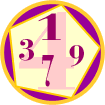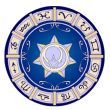Read the text and answer the questions below.
What is Numerology?
 Each day, we are exposed to numbers. We have phone numbers, birthdates, even
our financial information is driven by numbers. Numerology is the study of the
numbers in our lives and how they affect us. A student of numerology uses the
letters in a word, such as a full name, or a birth date and reduces that to a
single number. That number tells them certain things about the person's
character, what strengths and weaknesses they possess; it can even be used to
predict their future. Numerology is often closely associated with astrology as
astrologists assigned the numbers 0 through 9 to each celestial body in the
solar system and each number has its own set of values.
Each day, we are exposed to numbers. We have phone numbers, birthdates, even
our financial information is driven by numbers. Numerology is the study of the
numbers in our lives and how they affect us. A student of numerology uses the
letters in a word, such as a full name, or a birth date and reduces that to a
single number. That number tells them certain things about the person's
character, what strengths and weaknesses they possess; it can even be used to
predict their future. Numerology is often closely associated with astrology as
astrologists assigned the numbers 0 through 9 to each celestial body in the
solar system and each number has its own set of values.
 Numerology has been around for thousands of years. The Egyptians and
Babylonians both used it over 10,000 years ago. Pythagoras, a mathematician
whose theories are still in use today, is believed to have official organized
numerology in Greece over 2,500 years ago. He held the view that math concepts
were easier to regulate and classify than physical ones. Other beliefs and
writings important in the development of numerology were early Christian
mysticism, the Chinese Circle of the Dead, the Kabbalah, and the Indian Vedas.
At the beginning of the 20th century, L. Dow Balliet published the first book
about numerology, beginning what is known as the modern phase of numerology and
interest in it grew over the next few decades. Recently, a revival of interest
in numerology has occurred and many people are learning how numbers might affect
them.
Numerology has been around for thousands of years. The Egyptians and
Babylonians both used it over 10,000 years ago. Pythagoras, a mathematician
whose theories are still in use today, is believed to have official organized
numerology in Greece over 2,500 years ago. He held the view that math concepts
were easier to regulate and classify than physical ones. Other beliefs and
writings important in the development of numerology were early Christian
mysticism, the Chinese Circle of the Dead, the Kabbalah, and the Indian Vedas.
At the beginning of the 20th century, L. Dow Balliet published the first book
about numerology, beginning what is known as the modern phase of numerology and
interest in it grew over the next few decades. Recently, a revival of interest
in numerology has occurred and many people are learning how numbers might affect
them.
 Although methods may vary, typically a numerologist reduces a word or number
using a procedure called digit summing. If the numerologist is dealing with a
number, such as a birth date, they add up all the numbers. If the sum is two or
more digits, then those numbers are added until there is a single digit left.
When dealing with a word, such as a name, each letter of the alphabet is
assigned a number. For example, A =1, B = 2, C = 3. Then the same steps as above
are followed - the numbers are summed until one digit remains. Some
numerologists will not break numbers that total 11, 22, or 33. These are known
as master numbers and are considered to have higher vibrations as than the
numbers they would create if digitally summed.
Although methods may vary, typically a numerologist reduces a word or number
using a procedure called digit summing. If the numerologist is dealing with a
number, such as a birth date, they add up all the numbers. If the sum is two or
more digits, then those numbers are added until there is a single digit left.
When dealing with a word, such as a name, each letter of the alphabet is
assigned a number. For example, A =1, B = 2, C = 3. Then the same steps as above
are followed - the numbers are summed until one digit remains. Some
numerologists will not break numbers that total 11, 22, or 33. These are known
as master numbers and are considered to have higher vibrations as than the
numbers they would create if digitally summed.
Below is a brief definition of each number:
One - Because it is the first number, one is seen as having great power. Usually seen as "male," one can be happy, loving and dynamic while also being alone and egotistical.
Two - Associated with "female" energy, two often represents partnerships and interacting with others. It can also stand for the polar opposites of things such as black and white or good and evil. This number is best symbolized by the Chinese symbol Yin-Yang.
Three - Three is often related to learning through life experiences. It is often considered lucky and magical. It can mean both wisdom and understanding, yet also be foolish and negative.
Four - The first composite number (the first number to be created by multiplying numbers other than one and itself), four is associated with the four cardinal points (North, South, East and West), the four Gospels of the Bible, and time (four seasons, roughly four weeks in each month). It is a homonym for the Chinese word for "death," therefore; some hospitals do not have a fourth floor.
Five - Five is related with the five senses (smell, touch, taste, hearing, and sight) and often represents service to others as well as openness to new experiences, but it can also represent an addictive personality.
Six - The number six relates to beauty and often helps in building relationships. It is believed to hold charm, sensuality, and diplomacy. Six is also considered the mother/father number.
Seven - A spiritual number, seven can be both dreamy and spiritual while also being deceptive and insincere.
Eight - Eight represents hard work and life lessons. Because of that, eight is seen as seeking financial and material success, but is also associated with the hardships encountered while seeking both.
Nine - A sacred number, nine is viewed as a humanitarian number and holds mystical significance due to the nine-month gestational period for humans.
Numerology has been around for thousands of years. As with astrology, some see numerology as an occult science with little meaning, while others see it as a viable way to help them understand themselves and the world around them.
article written by Michelle Andersen
About the author:Michelle Andersen is an astrologer providing valuable tips and advice on understanding Chinese astrology, pet horoscopes, and zodiac compatibility. Choose from any one of three free readings - psychic love, tarot cards, or numerology reading.








